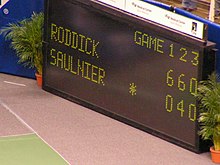Tennis
 Tennis pictogram | |
| Highest governing body | International Tennis Federation |
|---|---|
| First played | 19th century, Birmingham, England, United Kingdom |
| Characteristics | |
| Contact | No |
| Team members | Singles or doubles |
| Mixed sex | Yes, separate tours and mixed doubles |
| Type | Outdoor or indoor |
| Equipment | Ball, racket, net |
| Venue | Tennis court |
| Glossary | Glossary of tennis terms |
| Presence | |
| Country or region | Worldwide |
| Olympic | Part of Summer Olympic programme from 1896 to 1924 Demonstration sport in the 1968 and 1984 Summer Olympics Part of Summer Olympic programme since 1988 |
| Paralympic | Part of Summer Paralympic programme since 1992 |





Tennis is a sport played with a felt-covered rubber ball, a tennis racket, and a court.
First, early in the 11th century, players in France played a sport like this with their hands. It was called “Jeu de Paume”. In the 15th century the players played with rackets. Now it is called “tennis”. It became popular in England and France. King Henry III of France was a big fan of the game. This kind of sport is still played but is known as real tennis ("real" here meaning "royal"). The sport of "lawn tennis" played on grass courts was invented in mid 19th-century England and later spread into many other countries.[1][2]
Tennis matches
[change | change source]There are many different kinds of courts, like grass, clay or hard court. The goal of tennis is to hit the ball over the net into the other player’s court. When the other player cannot return the ball, a point is won. The game is played with two or four people. When it is played with two people, it is called “singles”, and when it is played with four people, it is called “doubles”. The court has "alleys" on each side, which are "fair" territory when playing doubles.
A tennis game has a number of sets. Each set has a number of games, and each game has points. The points are counted love (0, after the French l'oeuf), fifteen (15), thirty (30), and forty (40). If both players get to forty, the score is deuce from which 2 more points are needed to win the game. When one player reaches six games, it is one set. If it is a three-set match, the player who wins two sets first is the winner. If the game count reaches 5–5, the set must be won with two more games than the other player, like 7–5 or 8–6. If the game count gets to 6–6, a "tiebreaker" is played. In a tiebreak, players have to get at least seven points while getting two more points than the other player to win the set. In tiebreak points are called “one,” “two,” etc.
Soft tennis
[change | change source]There is also soft tennis. Soft tennis is different from regulation tennis. For example, the racket, ball and rules are much different. Soft tennis is popular in Japan. Thousands of people play soft tennis. Tennis is quite a popular sport which lots of people enjoy watching.
Shots
[change | change source]There are many different "shots" and "strokes", ways to hit the ball, in tennis. A stroke is the way the body is moved to hit the ball. A shot is how the ball is hit. These include:
- Strokes
- The backhand is a type of stroke hit by swinging the racquet away from the body. The stroke begins with the arm holding the racquet held across the body. It is then moved in front of the body to hit the ball. For a right-handed player, a backhand begins on the left side of his body, continues across his body as the ball is hit, and ends on the right side of his body. It can be either a one-handed or a two-handed stroke.
- The forehand is the opposite of the backhand. It starts with the arm outside of the body and moves across the body. For a right handed player, the arm starts on the right side of the body and moves across the body to the left side. The forehand is hit with one hand (most commonly the hand the player uses to write).
- Shots
- A serve (sometimes called a service) is a shot to start a point. The serve is usually started by tossing the ball into the air and hitting it across the net. The serve may be done underhand or overhead. The overhead serve the most common form. The serve is done from behind the baseline (the line at the back of the court). The serve must land on the inside of the service line and center service line on the other side of the net to call it good. The serve that is set has to be in the box diagonal to where the server serves.
- A volley is a shot that is hit before the ball bounces on the ground. Usually, a player hits a volley while standing near the net. It is sometimes done farther back, in the middle of the court or even near the back.
- A drop shot is tapping . A good drop shot travels just far enough that the opponent cannot run fast enough to get to it.
- A lob is a shot that can use backhand or forehand swings. For a lob the person has to swing through, but make the tennis ball go up. When the ball goes up the goal is for the ball to land in between the baseline (the line at the back of the court) and the service line.
Four Grand Slams
[change | change source]Tennis is now a sport that is played at the Olympics. They also have big tournaments like the U.S. Open, Australian Open, French Open and Wimbledon. These four are known as Grand Slam events.
- Australian Open (January)
- French Open ( May-June)
- Wimbledon (June - July)
- US Open (August-September)
Winning all four Grand Slams in the same year is called a Calendar Slam. They are the most important tennis tournaments of each season (year). This is because of the world ranking points, tradition, prize-money, and public attention.[source?]
Notes
[change | change source]- ↑ Tyzack, Anna, The True Home of Tennis Country Life, 22 June 2005
- ↑ History of Tennis Archived 2010-03-22 at the Wayback Machine International Tennis Federation. Retrieved 28 July 2008.
